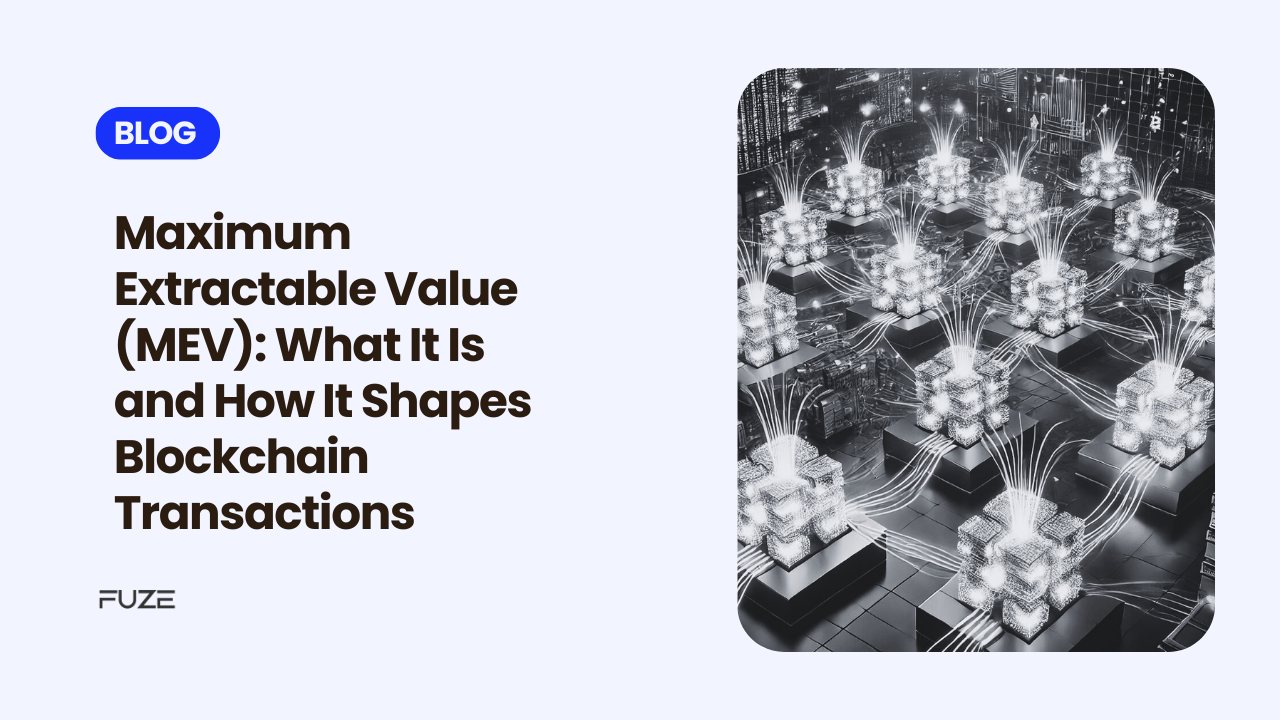Blockchain technology has revolutionized the financial landscape, giving rise to decentralized finance (DeFi) and transforming how we transact, invest, and innovate. At the heart of this transformation lies a complex interplay of opportunities and challenges, one of which is Maximum Extractable Value (MEV).
MEV represents both a critical dynamic and a persistent challenge in blockchain ecosystems. It refers to the profits that can be extracted by reordering, including, or excluding transactions within a block. While it showcases the efficiency of blockchain systems, it also reveals vulnerabilities that can affect transaction fairness, costs, and overall user experience.
In this blog, we’ll explore what MEV is, how it functions, its impact on blockchain networks, and the strategies being developed to address its effects.
What Is Maximum Extractable Value (MEV)?
MEV, or Maximum Extractable Value, is the maximum profit a blockchain validator, miner, or searcher can extract by reordering, including, or excluding transactions within a block. In other words, it is the value that can be captured from transaction sequencing on a blockchain network.
MEV is most commonly seen in blockchain networks such as Ethereum, where validators play a central role in organizing transaction data into blocks. MEV opportunities arise due to the permissionless and transparent nature of blockchain transactions, coupled with the economic incentives for validators or miners.
How Does MEV Work?
MEV exploits the freedom validators have in determining the order of transactions in a block. By strategically rearranging the order of transactions, validators can extract additional value, often at the expense of other users.
Here’s a simplified example:
- Arbitrage Opportunities: Suppose a trader submits a transaction to take advantage of a price difference between two decentralized exchanges (DEXs). A validator spots this transaction in the mempool (a queue of pending transactions) and places their own arbitrage transaction first, profiting from the price difference before the original trader can execute their trade.
- Front-Running: A validator can detect a lucrative transaction in the mempool, such as a large token swap. By placing their transaction ahead of it, they can manipulate the market and benefit from the resulting price movement.
- Back-Running: Conversely, validators can also place transactions immediately after a significant trade to profit from the residual price movement.
- Sandwich Attacks: This occurs when a validator places one transaction before and another after a target transaction, effectively “sandwiching” it. For example, a validator might buy a token just before a large purchase (driving the price up) and sell it immediately after for a profit.
Impacts of MEV on Blockchain Transactions
While MEV can be profitable, it also brings several problems to blockchain ecosystems:
- Higher Transaction Fees
MEV often results in gas auctions, where users have to pay higher transaction fees to ensure that their transactions are prioritized. This makes using blockchain networks expensive, especially during periods of high activity.
- Lack of Fairness
MEV further undermines the fairness of blockchain transactions in which validators and searchers can exploit their position, thus putting other regular users at a disadvantage because their transactions are delayed, manipulated, or excluded.
- Network Congestion
There is competition for capturing MEV opportunities, and this increases congestion in the mempool, thereby creating more delays and inefficiencies in processing transactions.
- Security Risks
High MEV can encourage malicious behaviors, such as validator collusion or chain reorganization attacks, which can compromise the security of the blockchain network.
The Role of Validators and Searchers in MEV
Validators/Miners
Validators have direct control over the inclusion and ordering of transactions in a block. By identifying profitable opportunities in the mempool, they can manipulate transaction sequencing to capture MEV.
Searchers
Searchers are entities or individuals that monitor the mempool for MEV opportunities. They utilize advanced algorithms and bots to identify and exploit such opportunities. Searchers usually pay validators a share of their earnings to prioritize their transactions, often through mechanisms like Priority Gas Auctions (PGAs).
Mitigating the Effects of MEV
Although MEV is an integral part of the blockchain network, various countermeasures have recently emerged to neutralize its harmful effects:
- Flashbots and Private Transaction Pools
Flashbots present a way in which the MEV extraction process by validators and searchers is carried out more transparently without causing mempool congestion. The transactions are privately submitted to the validators, rather than having the public visibility on the mempool.
- Fair Ordering Protocols
Some blockchain projects are designing mechanisms to enforce fair transaction ordering. Some of these protocols eliminate the liberty to reorder transactions in an effort to prevent front-running and other manipulative behaviors.
- Layer 2 Solutions
Layer 2 solutions, such as rollups, can reduce MEV since some of the transactions may be processed off-chain or in batch formats, making it even more difficult for validators to manipulate them.
- Decentralized MEV Redistribution
Some protocols redistribute MEV profits to the network participants so that the value extracted benefits the community rather than individual actors.
- User Awareness and Tools
Educating users about MEV and providing tools to minimize exposure, such as submitting private transactions, can help reduce the risks associated with MEV exploitation.
The Dual Nature of MEV
MEV is a double-edged sword. On one hand, it gives economic incentives to validators and searchers, contributing to the network’s overall functionality. On the other hand, it can harm users by increasing transaction costs and reducing fairness.
The challenge is in achieving a balance between allowing MEV as a natural part of blockchain economics while mitigating the negative consequences. Innovations like Flashbots and fair ordering protocols represent a massive step in this direction.
How MEV Shapes the Future of Blockchain
As blockchain technology develops, so will the MEV dynamics. Its presence underscores the intricacy of decentralized systems and the ongoing need for innovation to guarantee efficiency, security, and fairness. Here is how MEV is likely to mold the blockchain landscape:
- Evolution of Protocol Designs: New blockchain protocols will be designed to minimize MEV risks, such as ordering or encrypted transactions.
- Enhanced Transparency: Tools such as Flashbots will make MEV extraction more transparent and equitable.
- Wider Education: With increased awareness, users and developers will embrace practices that reduce the impact of MEV on everyday transactions.
Conclusion
Maximum Extractable Value (MEV) is the defining phenomenon in blockchain ecosystems, showcasing both the opportunities and challenges of decentralized transaction processing. It can drive economic incentives and innovation but also raises important questions about fairness, cost, and security.
It is crucial for anyone associated with the blockchain, either as a developer, validator, or user, to understand MEV. The community of blockchains can take measures such as mitigation and innovation so that the MEV-related challenge is addressed to ensure a much more inclusive and efficient ecosystem.
Disclaimer: Virtual assets carry significant risks, including high volatility and potential loss of your entire investment. They are not backed by governmental protections, and recourse may be limited in case of loss. Always assess your risk tolerance, fully understand the risks, and seek independent financial advice if needed before investing.
Frequently Asked Questions
How do miners and validators extract MEV?
Miners and validators can extract MEV by selecting or ordering transactions in a way that benefits them, such as by including high-fee transactions first or reordering trades in DeFi protocols to capture price discrepancies.
Can MEV be prevented or minimized?
While MEV cannot be entirely eliminated, strategies like transaction ordering protections (e.g., Fair Ordering Services), changes to consensus mechanisms, and the development of new protocols (like Flashbots) aim to reduce its negative effects on blockchain networks.
What is the role of Flashbots in MEV?
Flashbots is an organization focused on researching and developing solutions to mitigate the harmful effects of MEV. They provide a transparency layer and offer solutions like MEV-Geth, which helps miners capture MEV more efficiently and fairly.
How does MEV impact DeFi protocols?
In DeFi, MEV can lead to significant price slippage, exploitative arbitrage opportunities, and inefficient liquidity usage. It can also affect the security and stability of DeFi protocols by incentivizing malicious behavior.
What is the relationship between MEV and transaction fees?
Higher transaction fees can often be used by users to “outbid” others, ensuring their transaction gets processed before others, which in turn may drive up the overall cost of using a network. This creates a bidding war for miners or validators who want to maximize their profits.







